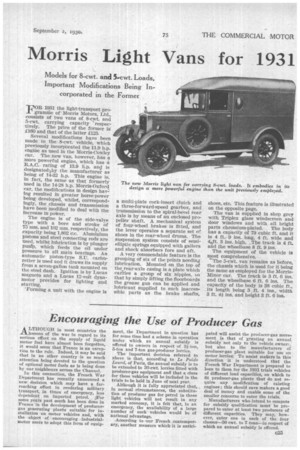Morris Light Vans for 1931
Page 47

If you've noticed an error in this article please click here to report it so we can fix it.
Models for 8-cwt. and 5-cwt. Loads, Important Modifications Being In corporated in the Former
MIOR 1931 the light-transport pro
gramthe of Morris Motors, Ltd„ consists of two vans of 8-cwt. and 5-cwt. carrying capacity respectively. The price of the former is mo and that of the latter £125.
Several modifications have been made to the 8-cwt. vehicle, which previously incorporated the 11.9 h.p. engine as used in the Ittlorris-Cowley car. The new van, however, has a more powerful engine, which has a R.A.C. rating of 13.9 lip. and is designatedipy the manufacturer as being of 14-32 h.p. This engine is, in fact, the same as that formerly used in the 14-28 h.p. Morris-Oxford car, the modifications in design hay: ing resulted in greater horse-power being developed, whilst, correspondingly, the chassis and transmission have been modified to deal with the increase in power.
The engine is of the side-valve type with a bore and stroke Of 75 mm. and 102 mm, respectively, the capacity being 1,802 e.c. Aluminium pistons and steel connecting rods are used, whilst lubrication is by plunger purdp, which feeds the oil under pressure to all main bearings. An automatic piston-type S.U. carburetter is used and it draws its supply from a seven-gallon tank mounted on the steel dash. Ignition is by Lucas magneto and a Lucas 12-volt dynamotor provides for lighting and starting.
'Forming a unit with the engine is a multi-plate cork-insert clutch and a three-forward-speed gearbox, and transmission to the spiral-bevel rear axle is by means of an enclosed propeller shaft. A mechanical system of four-wheel brakes is fitted, and the lever operates a separate set at shoes in the rear-wheel drums. The suspension system consists of semielliptic springs equipped with gaiters and shock absorbers fore and aft.
A very commendable feature is the grouping of six of the points needing lubrication. Mounted on the top of the rear-axlecasing is a plate which carries a group of six nipples, 11.0 that by simply lifting the floorboards the grease gun can be applied and lubricant supplied to such inaccessible parts as the brake shafts, shoes, etc. This feature is illustrated on the opposite page.
The van is supplied in shop grey with Triplex glass windscreen and door windows and with all bright parts chromium-plated. The body has a capacity of 79 cubic ft. and it is 4 ft. 9 ins. long, 4 ft. wide and 44t. 3 ins. high. The track is 4 ft. and the wheelbase 8 ft. 9 ins.
The equipment of the vehicle is most comprehensive.
The 5-cwt. van remains as before, the chassis which is used for it being the same as employed for the MorrisMinor car. The track is 3 ft. 6 ins. and the wheelbase 6 ft. 6 ins. The capacity of the body is 38 cubic ft., its length being 3 ft. 4 ins., width 3 ft. 4i ins, and height 3 ft. 6 ins.












































































































